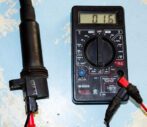
How to check the ignition coil with a multimeter
Content
If the ignition coil fails, the engine of a modern car stops starting. Computer diagnostics of a car does not always determine a coil malfunction; in such a case, the old and proven method of checking it by means of a universal device (multimeter) in the ohmic resistance measurement mode does not fail.
The purpose of the ignition coil and its types
An ignition coil (also called a bobbin) converts an electrical impulse from the on-board battery into a high voltage peak, applied to the spark plugs installed in the cylinders, and creates an electric spark in the spark plug air gap. A low-voltage pulse is generated in the chopper (distributor), switch (ignition amplifier) or engine control unit (ECU).

For electrical breakdown of the spark plug air gap of the order of 0,5-1,0 mm, a pulse with a voltage of at least 5 kilovolts (kV) per 1 mm of the gap is required, i.e. an electrical impulse with a voltage of at least 10 kV must be applied to the candle. For greater reliability, taking into account the possible voltage loss in the connecting wires and an additional limiting resistor, the voltage generated by the coil should reach up to 12-20 kV.
Attention! The high voltage pulse from the ignition coil is dangerous to humans and may even cause electric shock! Discharges are especially dangerous for people with cardiovascular diseases.
Ignition coil device
The ignition coil is a step-up transformer with 2 windings - low-voltage and high-voltage, or an autotransformer, in which both windings have a common contact, designated "K" (body). The primary winding is wound with a varnished copper wire of large diameter 0,53-0,86 mm and contains 100-200 turns. The secondary winding is wound with a wire with a diameter of 0,07-0,085 mm and contains 20.000-30.000 turns.
When the engine is running and the camshaft rotates, the cam mechanism of the distributor sequentially closes and opens the contacts, and at the moment of opening, the current changing in the primary winding of the ignition coil according to the law of electromagnetic induction induces a high voltage.

In a similar scheme, which was used until the 90s, electrical contacts in the opening circuit often burned out, and in the last 20-30 years, electrical equipment manufacturers have replaced mechanical breakers with more reliable switches, and in modern cars, the operation of the ignition coil is controlled by the engine control unit, in which is the built-in switch.
Sometimes the switch is structurally combined with the ignition coil, and if it fails, you have to change the switch together with the coil.
Ignition coil types
There are mainly 4 types of ignition coils used in cars:
- common to the entire ignition system;
- common twin (for 4-cylinder engines);
- general triple (for 6-cylinder engines);
- individual for each cylinder, double.
The common twin and triple coils simultaneously generate sparks in the cylinders operating in the same phase.
Checking the health of the ignition coil with a multimeter
Start checking the ignition coil with its "continuity", ie. measuring the resistance of wire windings.
Checking common ignition coils
Checking the coil should begin with its primary winding. The winding resistance, due to the small number of turns of the thick wire, is also low, in the range from 0,2 to 3 Ohm, depending on the coil model, and is measured in the multimeter switch position "200 Ohm".
The resistance value is measured between the terminals "+" and "K" of the coil. Having called the contacts "+" and "K", you should measure the resistance of the high-voltage coil (for which the switch of the multimeter should be switched to the "20 kOhm" position) between the terminals "K" and the output of the high-voltage wire.

To make contact with the high-voltage terminal, touch the multimeter probe to the copper contact inside the high-voltage wire connection niche. The resistance of the high-voltage winding should be within 2-3 kOhm.
A significant deviation of the resistance of any of the coil windings from the proper one (in the extreme case, a short circuit or an open circuit) clearly indicates its malfunction and the need to replace it.
Checking dual ignition coils
Testing dual ignition coils is different and somewhat more difficult. In these coils, the leads of the primary winding are usually brought out to the pin connector, and for its continuity, you need to know which pins of the connector it is connected to.
There are two high-voltage terminals for such coils, and the secondary winding should be ringed by contacting the multimeter probes with both high-voltage terminals, while the resistance measured by the multimeter may be slightly higher than that of the coil common for the entire system, and exceed 4 kΩ.

Checking individual ignition coils
The reason for the absence of a spark with individual ignition coils, in addition to the failure of the coil itself (which is checked with a multimeter as described above), may be a malfunction of the additional resistor built into them. This resistor can be easily removed from the coil, after which its resistance should be measured with a multimeter. The normal resistance value ranges from 0,5 kΩ to several kΩ, and if the multimeter shows an open circuit, the resistor is faulty and must be replaced, after which a spark usually appears.
Video instruction for checking ignition coils


Watch this video on YouTube
Questions and answers:
How to check the ignition coil of a VAZ with a Multimeter? For this, the coil is easier to dismantle. The resistance is measured on both windings. Depending on the type of coil, the contacts of the windings will be in different places.
How to check a coil with a multimeter? First, the probe is connected to the primary winding (the resistance in it should be within 0.5-3.5 ohms). A similar action is carried out with the secondary winding.
Can I check the ignition coil? In the garage, you can independently check only the ignition coil with a battery-type ignition (old production). Modern coils are checked only at a car service.

